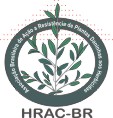SOURGRASS PHENOLOGICAL STAGE AND EFFICACY OF GLUFOSINATE-AMMONIUM
Resumo
Recently, biotypes of sourgrass (Digitaria insularis) were identified in Brazil with multiple resistance to EPSPs-ACCase inhibiting herbicides, what demands the recommendation of herbicides with alternative mode of action, such as glufosinate-ammonium. Glufosinate-ammonium acts inhibiting glutamine synthetase, which is a key enzyme on nitrogen assimilation metabolism. This herbicide may be applied on mono or dicots; however, its efficacy may be influenced by plants’ phenology at the moment of application. Therefore, this work was developed with the objective of modelling the efficacy of glufosinate-ammonium on sourgrass regarding to five different phenological stages. Treatments consisted of eight herbicide rates (1,600, 800, 400, 200, 100, 50 and 25 g ha-1, and check plots without herbicide application) and five phenological stages of sourgrass. Percentage control was evaluated at 14, 21 and 28 days after application (DAA), as well as shoot dry weight at 28 DAA. The more developed sourgrass plants were, the higher doses of glufosinate-ammonium were needed to achieve satisfactory control. Glufosinate-ammonium is an excellent alternative for controlling sourgrass, however a second herbicide may be necessary for applications after tillering. Strong relation between sourgrass phenological development and increasing necessary rates of glufosinate-ammonium was identified.
Palavras-chave
growth; glutamine synthetase; modelling; Digitaria insularis
DOI: https://doi.org/10.7824/rbh.v1i1.764
Apontamentos
- Não há apontamentos.
Revista Brasileira de Herbicidas
ISSN (Online) 2236-1065
ISSN (IMPRESSO de 2000 a 2005) 1517-9443
ISSN (IMPRESSO de 2000 a 2005) 1517-9443
Complexo Empresarial Oscar Fuganti
Rua Santa Catarina, 50 - 13º andar - sala 1302
Londrina - Paraná
CEP: 86010-470
Email: contato@rbherbicidas.com.br
TEL: (43) 3344-3364
Segunda à Sexta — 12:00 às 18:0











